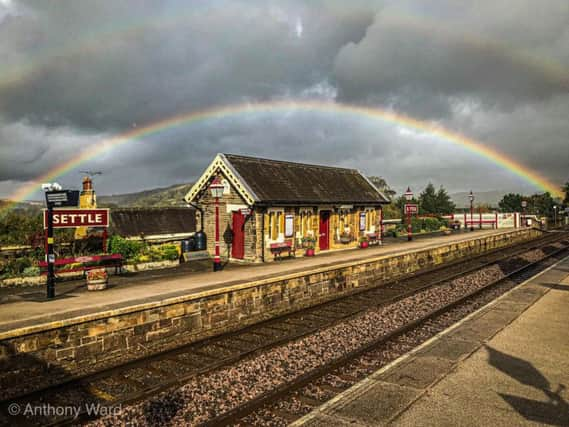Railway volunteer takes stunning photo of double rainbow over the Yorkshire Dales


Anthony Ward, a volunteer on-board guide with the Settle to Carlisle Railway, took the picture at Settle Station earlier this week.
Two rainbows can be seen in a tempestuous sky above the quaint Victorian station.
Advertisement
Hide AdAdvertisement
Hide AdWhat causes a double rainbow?
Rainbows always form in pairs, but usually only the primary rainbow can be seen. Secondary rainbows are larger but fainter.
Both primary and secondary rainbows can be seen when a 'double' is visible,
Secondary rainbows are caused by a double reflection of sunlight inside water droplets. Technically the secondary bow is centred on the sun itself, but since its angular size is more than 90 degrees, it is seen on the same side of the sky as the primary rainbow. As a result of the 'inside' of the secondary bow being 'up' to the observer, the colours appear reversed compared to those of the primary bow.
Advertisement
Hide AdAdvertisement
Hide AdThe secondary rainbow is fainter than the primary because more light escapes from two reflections compared to one and because the rainbow itself is spread over a greater area of the sky. Each rainbow reflects white light inside its coloured bands, but that is 'down' for the primary and 'up' for the secondary.
Settle to Carlisle Railway
The 73-mile long route through the Yorkshire Dales is often considered to be England's most scenic railway journey, as it traverses dramatic landscapes and includes imposing structures such as the Ribblehead Viaduct. There are through trains to Leeds from Settle.
The line was constructed in the 1870s by navvy gangs, who lived in primitive camps that moved with the railway. It crosses some of the most hostile terrain in Britain.
By 1970s, its popularity as a route between England and Scotland had declined in favour of the faster West Coast Main Line, and British Rail started to consider closure, as repair costs for the Victorian viaducts and tunnels were high.
Advertisement
Hide AdAdvertisement
Hide AdDuring the 1980s, rail enthusiasts and local communities campaigned to save the line, and in 1989 it was finally given a reprieve.
Since then, its fortunes have been reversed - tourism has helped to boost passenger numbers, which now stand at well over a million every year. Eight mothballed stations have been re-opened, freight usage has increased and there line is also hugely popular with steam charter excursions.
It remains vulnerable to the elements - parts of the route were closed for almost a year between 2016 and 2017 after a major landslide.